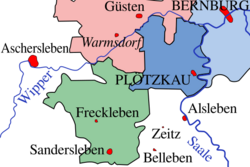Principality of Anhalt-Plötzkau
 From Wikipedia the free encyclopedia
From Wikipedia the free encyclopedia
This article needs additional citations for verification. (June 2024) |
Principality of Anhalt-Plötzkau Fürstentum Anhalt-Plötzkau | |||||||||
|---|---|---|---|---|---|---|---|---|---|
| 1544–1553 1603–1665 | |||||||||
 The Principality of Anhalt-Plötzkau (blue) in 1611. | |||||||||
| Status | Principality | ||||||||
| Capital | Plötzkau | ||||||||
| Government | Principality | ||||||||
| Historical era | Middle Ages | ||||||||
• Partitioned from Anhalt-Dessau | 1544 1544 | ||||||||
• Inherited by Anhalt-Zerbst | 1553 | ||||||||
• Partitioned from Anhalt-Zerbst | 1603 | ||||||||
• Inherited Anhalt-Zerbst | 1665 | ||||||||
• Duchy of Anhalt reunited | 1863 | ||||||||
| |||||||||
Anhalt-Plötzkau was a principality located in Germany. It existed on two occasions. It was first established in 1544 following the partition of Anhalt-Dessau, but the principality ceased to exist following the death of Prince George III in 1553, at which point it was inherited by the prince of Anhalt-Zerbst.[citation needed]
It was reestablished in 1603 with the partition of the unified principality of Anhalt;[1] this time, in order to create a bigger principality, parts of Anhalt-Bernburg were extracted.[citation needed] This second incarnation lasted until 1665, at which point Prince Lebrecht succeeded as Prince of Anhalt-Köthen and Plötzkau returned to the principality of Anhalt-Bernburg.[2]
Princes of Anhalt-Plötzkau (1544-1553)
[edit]- George III 1544–1553[3]
To Anhalt-Zerbst 1553.
Princes of Anhalt-Plötzkau (1603-1665)
[edit]- Augustus 1603–1653
- Ernest Gottlieb 1653–1654
- Lebrecht 1653–1665 (co-regent)
- Emmanuel 1653–1665 (co-regent)
United with Anhalt-Bernburg 1665.
References
[edit]- ^ Engel, Arthur; Serrure, Raymond (1897). Traite de Numismatique Modern et contemporaine. Vol. 1. Paris: Ernest Leroux. p. 303.
- ^ Chisholm, Hugh, ed. (1911). . Encyclopædia Britannica. Vol. 2 (11th ed.). Cambridge University Press. p. 45.
- ^ Kloth, Karen; Trondle-Weinritt, Isolde; et al., eds. (2000). Handbuch Der Historischen Buchbestände In Deutschland. Olms-Weidmann. p. 35. ISBN 3487107791.
